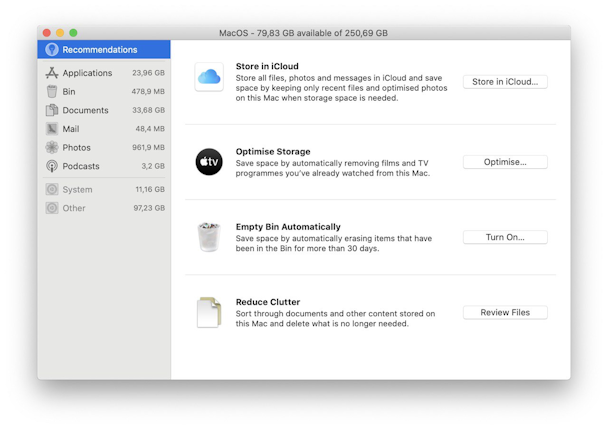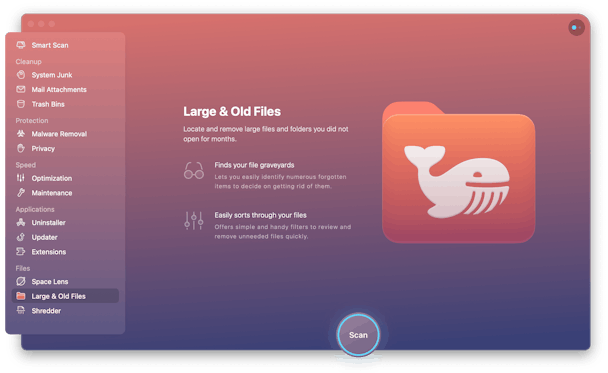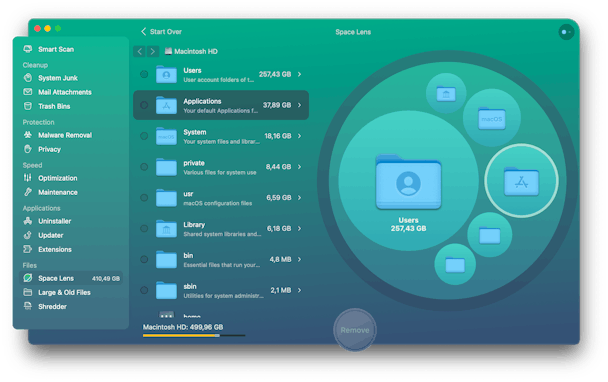how to find out what is taking up space on my mac
In this age of terabyte flash drives and deject storage, it'south easy to forget that storage space is finite. Only it is, and as software gets more sophisticated and must-accept apps become more than plentiful, you can swallow through a 1TB SSD in no time at all.
Certain, in theory, if your Mac difficult drive gets full y'all tin can just upgrade, simply at effectually $800 for a 2TB iMac SSD and $2800 for a 4TB SSD neither option is exactly affordable. Plus, information technology'south non just room for files that you lot go from a hard drive, information technology directly affects performance too. Allow your difficult drive get full and see how sluggish your Mac runs. Actually, don't do that y'all'll bulldoze yourself crazy.
For optimum performance, you lot should continually monitor Mac hard drive infinite to make sure there's always room for your next large download. Keep reading to acquire how to discover storage on your Mac and apply information technology more efficiently.
How to check storage on your Mac?
The simplest way to check Mac difficult drive space is past accessing About This Mac.
- Click on the Apple icon and choose About This Mac.
- Click on Storage.

Note: If you're running an older version of Os 10, you lot may need to click More than Info to find the Storage option.
The Storage tab will show you how much space is existence taken up by the Arrangement, Documents, Apps, and more. It will besides brandish bachelor space.
What to do when your hard drive is total?
If your Mac difficult drive is nearing chapters, your system volition let y'all know with a "disk almost full" warning prompting y'all to free upwardly some infinite.

If you lot meet this alarm it'south all-time to act on it. To complimentary up infinite on your startup disk you'll demand to do 1 or all of these iii things:
- Delete files
- Movement files over to cloud storage or an external hard drive
- Install a second difficult bulldoze or add together a larger startup disk
Options ane and two are the easiest, simply if you're thinking of upgrading your existing disk, bank check out our guide.
If you're running macOS Sierra or higher, you can get some costless space by optimizing your storage with in-build tools. To do this, get to the Apple menu and select About This Mac. Here, get to the Storage tab and press Manage.
In the window that appears, you tin can see some tips on reclaiming complimentary space. Hither'southward how to manage storage on your Mac:

- Click Store in iCloud. Cull what information you lot want to transfer to iCloud and confirm.
- Click Optimize to remove movies and Television set programs.
- Turn on Empty Bin Automatically.
- Click Reduce Clutter to review all your documents.
This is a quick and piece of cake fashion to free upward space but it'south not ideal. Yous see, when files are moved to iCloud, junk and useless files are moved likewise. This means you max out your iCloud storage quicker and end up having to pay for more. For this reason, we recommend using CleanMyMac X to detect junk files and completely remove them from your system.
Delete large and onetime files starting time
Usually, one-time large files are the biggest space wasters on our Macs. It probably happens to anyone: you open up your brand new MacBook and download multiple files, which seem to be very useful at start. Only, later, you forget nearly these items, and they end up cluttering your storage. It's time to dig up these old massive files. And CleanMyMac 10 can assist y'all out with that chore.
With a defended Big & Old Files module, yous can quickly clear your Mac.
- Download CleanMyMac 10 (a free trial is bachelor).
- Install and launch the app.
- Become to the Large & Old files module.
- Press Scan.

Now, all y'all take to do is select former files that CleanMyMac X has institute and press Remove.
Another CleanMyMac 10 useful feature is Space Lens. It builds a virtual map of your storage, so you can meet where all your space is gone. You need but to hover over any folder to find out its weight or click it to view its contents.

How to free upward Mac hard drive infinite manually
Deleting files manually is a simple task, but it tin as well be time-consuming. The best style to go most it is to find erstwhile documents, downloads, music, and applications yous no longer need and drag them to the Trash.
When you do this y'all'll need to recollect to empty the Trash, otherwise, files will only sit at that place and gratuitous up no space at all.
- Right-click Trash in the Dock.
- Select Empty Bin and confirm.
You can also remove old iTunes Library backups, iOS backups and updates, and clear cached files using the Finder.
- Open up a Finder window and select Go in the bill of fare bar.
- Click on Get to Folder and enter ane of the post-obit commands:
- Caches:
~/Library/Caches - iTunes Library backups:
~/Music/iTunes/Previous iTunes Libraries - iOS backups:
~/Library/Application Support/MobileSync/Backup/ - iOS software updates iPad:
~/Library/iTunes/iPad Software Updates - iOS software updates iPhone:
~/Library/iTunes/iPhone Software Updates

iii. Browse each of the folders and delete whatever files you no longer need.
Every bit said, immigration files manually is easy merely it comes with one rather sizeable caveat: moving things to Trash leaves behind a residue — leftover pieces of files that serve no purpose other than to take upward hard drive space. There you are doing your best to remove files just for Mac to be incapable of fully deleting whatever y'all want to get rid of.
And so, what tin you do virtually that? Aye… CleanMyMac X.
Freeing upwardly Mac hard drive infinite with CleanMyMac X
CleanMyMac X scours your system for all old, outdated, and broken files, and completely removes them from your system. It's the quickest and easiest way to free up a lot of infinite at one time.
If y'all need to optimize disk space in a hurry, download CleanMyMac Ten and select the option to clean upwards System Junk. This will remove old cache files and logs, cleaved app data, unused languages, and excessive versions of documents in a couple of clicks.
- Download and launch CleanMyMac X.
- Choose System Junk from the menu.
- Click Scan.
- Click Clean.

A total disk is something all Mac users experience at some betoken. Thankfully, it'southward easy to reclaim space using Mac's own optimization feature or the Finder if y'all're doing things manually, or CleanMyMac X if you prefer a more comprehensive solution. Every bit y'all'll likely need to make clean up the difficult drive a few times a year, we'd suggest going down the CleanMyMac X route but, of course, we're biased. Effort the different methods and see what works best for y'all.
Keep your Mac in good shape
I hope you managed to find out what exactly took too much space on your Mac. Here're some tips to forbid clutter in your storage in the future:
- Clear old files
To use your storage more efficiently, you lot demand to declutter your Mac once in a while. Remove apps, documents, photos, and media that you don't need on your Mac. Transfer your data to the hard drive or store it in the cloud. A perfectly organized storage also boosts your productivity, which is another reward of keeping your space tidy.
- Delete apps completely
And by "completely," I mean together with all the files associated with the app. Dragging an app to the Trash volition probably leave its data in your system. So, make sure y'all remove your apps using native uninstallers or special tools, similar CleanMyMac X.
- Empty Trash
This is pretty straightforward advice, but many of us still forget to do it. Trashed files can have gigantic amounts of space. Remember to clear the Bin after yous deleted some files on your Mac.
- Update your software
When you Mac acts laggy, you may think it's running out of infinite. But, outdated software tin can cause the same symptoms. Updates oft comprise bug fixes and improvements that tin can positively affect how your app and your Mac run. Updating both Os and apps to the latest version will ensure the smooth operation of your machine.
Frequently Asked Questions
What is taking up and so much space on my Mac?
To discover out what'due south taking storage on your Mac, go to the Apple menu. Hither, choose About This Mac. Get to the Storage tab and click Manage to see how much infinite takes each category.
How to notice big files on Mac?
In Finder, printing the little gear icon and select Show Search Criteria. Click Kind filter and choose Other. Then select File Size from the list. Select "is greater than" criteria in the 2nd box. Enter the size (for instance, 400 MB), and then the search results volition update, showing you the large files on your Mac.
How much space should the system take upwards on Mac?
Mac's arrangement takes about 20 GB on average. If your Mac's system is considerably bigger than xx-25 GB, try emptying the Trash. Performing a clean install may be necessary in some cases – information technology will reinstall your OS and articulate your storage. Merely, brand sure to support your data showtime.
Source: https://macpaw.com/how-to/check-storage-on-mac
0 Response to "how to find out what is taking up space on my mac"
Post a Comment